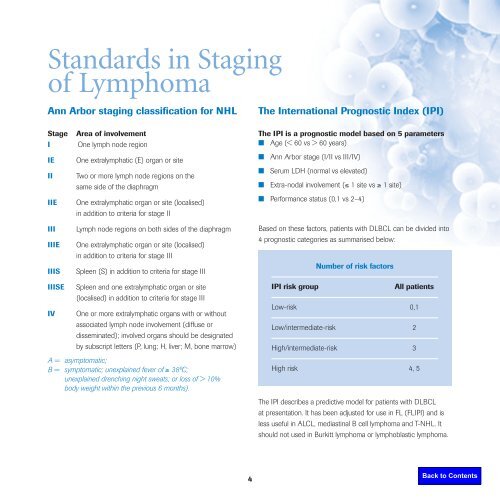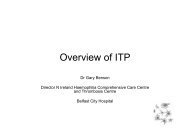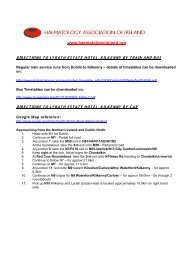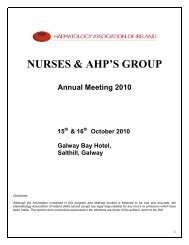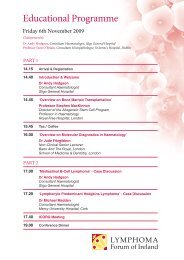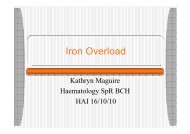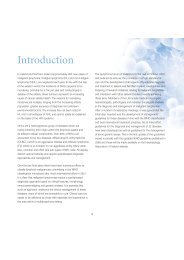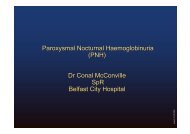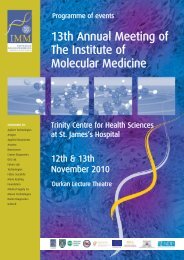Guidelines on Diagnosis and Treatment of Malignant Lymphomas
Guidelines on Diagnosis and Treatment of Malignant Lymphomas
Guidelines on Diagnosis and Treatment of Malignant Lymphomas
Create successful ePaper yourself
Turn your PDF publications into a flip-book with our unique Google optimized e-Paper software.
St<strong>and</strong>ards in Staging<br />
<strong>of</strong> Lymphoma<br />
Ann Arbor staging classificati<strong>on</strong> for NHL<br />
The Internati<strong>on</strong>al Prognostic Index (IPI)<br />
Stage<br />
I<br />
IE<br />
II<br />
IIE<br />
III<br />
IIIE<br />
IIIS<br />
Area <strong>of</strong> involvement<br />
One lymph node regi<strong>on</strong><br />
One extralymphatic (E) organ or site<br />
Two or more lymph node regi<strong>on</strong>s <strong>on</strong> the<br />
same side <strong>of</strong> the diaphragm<br />
One extralymphatic organ or site (localised)<br />
in additi<strong>on</strong> to criteria for stage II<br />
Lymph node regi<strong>on</strong>s <strong>on</strong> both sides <strong>of</strong> the diaphragm<br />
One extralymphatic organ or site (localised)<br />
in additi<strong>on</strong> to criteria for stage III<br />
Spleen (S) in additi<strong>on</strong> to criteria for stage III<br />
The IPI is a prognostic model based <strong>on</strong> 5 parameters<br />
■ Age (< 60 vs > 60 years)<br />
■<br />
■<br />
■<br />
Ann Arbor stage (I/II vs III/IV)<br />
Serum LDH (normal vs elevated)<br />
Extra-nodal involvement (≤ 1 site vs ≥ 1 site)<br />
■ Performance status (0,1 vs 2–4)<br />
Based <strong>on</strong> these factors, patients with DLBCL can be divided into<br />
4 prognostic categories as summarised below:<br />
Number <strong>of</strong> risk factors<br />
IIISE<br />
IV<br />
Spleen <strong>and</strong> <strong>on</strong>e extralymphatic organ or site<br />
(localised) in additi<strong>on</strong> to criteria for stage III<br />
One or more extralymphatic organs with or without<br />
associated lymph node involvement (diffuse or<br />
disseminated); involved organs should be designated<br />
by subscript letters (P, lung; H, liver; M, b<strong>on</strong>e marrow)<br />
A = asymptomatic;<br />
B = symptomatic; unexplained fever <strong>of</strong> ≥ 38ºC;<br />
unexplained drenching night sweats; or loss <strong>of</strong> > 10%<br />
body weight within the previous 6 m<strong>on</strong>ths).<br />
IPI risk group<br />
All patients<br />
Low-risk 0,1<br />
Low/intermediate-risk 2<br />
High/intermediate-risk 3<br />
High risk 4, 5<br />
The IPI describes a predictive model for patients with DLBCL<br />
at presentati<strong>on</strong>. It has been adjusted for use in FL (FLIPI) <strong>and</strong> is<br />
less useful in ALCL, mediastinal B cell lymphoma <strong>and</strong> T-NHL. It<br />
should not used in Burkitt lymphoma or lymphoblastic lymphoma.<br />
4


